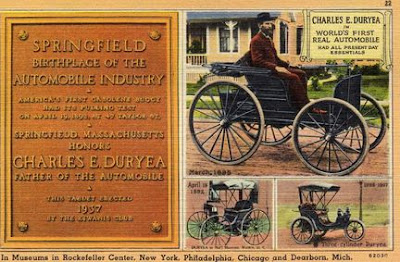Ask an American school child “who invented the automobile?” and the kid will probably say Henry Ford. Which, of course, is flat-out wrong. The automobile had many fathers. Ford was relatively late to the game. What he did do was revolutionize the manufacture of the machines by replacing the hand-built methods of the carriage makers and bicycle builders who dominated the early industry with the modern assembly line which so greatly reduced costs that cars went from the realm of playthings for the wealthy to work-day-transportation for the middle class.
Of course one of the reasons that school children and most grownups believe that he was the inventor is that he did everything possible to associate himself with Alexander Graham Bell, Thomas Alva Edison, Harvey Firestone, and the Wright Brothers in people’s minds, including bringing their shops and laboratories to his Greenfield Village educational park.
Steam powered self-propelled vehicles dated back to 1770. Germany’s Karl Benz invented an internal combustion engine and mounted it on a tri-cycle in 1885 and his future partner Gottlieb Daimler built a four-wheeled motorized carriage the next year, generally acknowledged to be the first automobile. Across Europe and America tinkerers were building cars and soon fledgling companies were founded for commercial production.
 |
| Charles Duryea. |
In Peoria bicycle shop owner Charles Duryea designed a self-propelled carriage with a gasoline powered internal combustion engine and built it with the help of his machinist brother Frank in Chicopee, Massachusetts in 1893. On June 11, 1895 Charles was issued a patent on the vehicle for what became the first commercially produced automobile in America. Frank built a second model the same year.
With Frank at the tiller the brothers entered the nation’s first automobile race in Evanston, Illinois and won the Chicago Times-Herald race on Thanksgiving Day. Riding the publicity of that win the brothers launched the Duryea Motor Wagon Company of Springfield, Massachusetts in 1896 which built 13 identical models for sale the first year.
Two of them were shipped across the Atlantic to Britain where Frank won that nation’s first race, the London to Brighton Emancipation Run, which celebrated a change in English law raising the speed limit for “light road locomotives” to a blazing 14 miles per hour and eliminated the requirement that they per proceeded by a man on foot to warn horse drawn carriages.
 |
| The crowded, humming little Duryea Motor Wagon factory in Springfield, Massachusetts. Each car was built by hand from the ground up with parts machined on site and took about a month to complete. |
The amid tensions between the brothers, the Springfield factory closed after two years and the company briefly relocated to Charles’s home town of Peoria where he developed and produced in limited numbers a three wheel model. Bickering between the brothers caused the firm to be dissolved in 1898.
By that time more than a dozen firms had sprung up to produce automobiles including Olds Motor Vehicle Company in Lansing, Michigan which in 1901 introduced the Curved Dash Oldsmobile, the first commercially successful model. It sold over 400 units that year.
Henry Ford introduced his Model A in 1903 with an asking price of $850, about half the cost of most of his competitors.
Meanwhile Frank Duryea returned to Massachusetts and joined the Stevens Arms and Tool Company which produced the Stevens-Duryea until 1927. Even many auto historians mistake this as the same company founded by the brothers in 1896.
Charles relocated to Pennsylvania and tried unsuccessfully several times to start companies to market his three-cylinder tiller operated tricycles. But technology had passed him by. He turned to journalism as a writer and editor for the Automobile Trade Journal. He died in Philadelphia in 1939 at the age of 76 a witness to the success of the industry he founded and the transformation of the country.



No comments:
Post a Comment